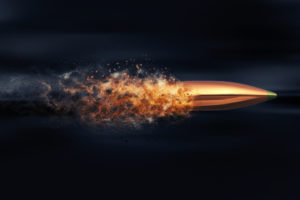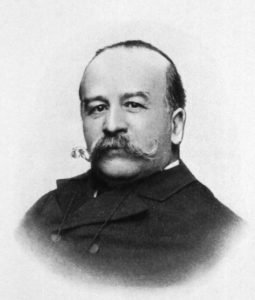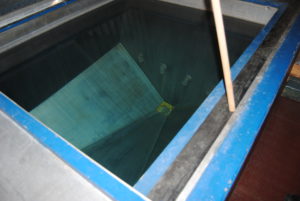
A new clue on a bullet
With his scalpel, the doctor carefully traced the wound track through the dead man’s body. It entered the man’s left chest and traveled downward. The bullet had passed the third rib, sliced through the right side of the heart, and then the diaphragm and liver. At the wall of the transverse colon he found it. Alexandre Lacassagne was not likely to overlook a good clue.
The bullet made a soft plink as the doctor set it aside for further examination. Even in the 19th century, the projectiles found in murder weapons could offer valuable clues. Their sizes offered clues to the caliber of the murder weapon, and their weight to their manufacturer.

Alexandre Lacassagne as the man for the hour
Alexandre Lacassagne, a French pathology professor, had an outstanding reputation in law enforcement. For good reason. He could coax evidence from dead bodies that most people overlooked. The pathologist founded his own school of criminology in Lyon, France, and took major steps in fashioning a field for a new brand of physician: the medical examiner. By February 1888, when Alexandre Lacassagne performed this autopsy, his school had already become famous.
When he examined the bullet more carefully, he noticed a clue he hadn’t seen before. Seven scratches etched its surface. The bullet was slightly deformed from having nicked that rib, but that didn’t explain the scratches on the other side of the bullet’s surface.
What could have caused them?
Rifling and striations
Lacassagne called in an expert, a gunsmith from the renowned weapons manufacturer Verney-Carron, who verified they came from the rifling grooves in the gun’s barrel. Seven was an unusual number for rifling, however.
Then a suspect was found in possession of the victim’s savings account book. He had an old Belgium revolver, and sure enough, it had seven grooves in the barrel. Alexandre Lacassagne didn’t stop there. He performed test shooting in his laboratory. With the suspect’s Belgium revolver, the pathologist shot bullets into a corpse wearing similar clothing as the victim’s and sought to recreate the same angle. Then he removed the bullets from the body and compared them with those from the victim. They matched. That evidence helped prove the case against the suspect.

Alexandre Lacassagne cracks yet another case
Alexandre Lacassagne worked on a similar case, also in February 1888. A bleeding 78-year-old man knocked at his neighbors’ door. He’d been shot several times, including through the larynx, and he couldn’t say what happened to him. He died several days later.
When Lacassagne dissected the bullets from the man’s body, he weighed them and examined their surface. The bullets appeared partially deformed. They sported an abnormal groove that didn’t seem to come from the firearm’s rifling. He called in the same gunsmith for an expert opinion.
When a revolver was found at the home of the suspect’s girlfriend, Alexandre Lacassagne again used it for test shooting. The gunsmith discovered that the revolver itself was slightly deformed: its sight protruded into the barrel, and that’s what caused the distinctive groove. The evidence was used to convict the suspect of murder.

Systematic research and publication
Realizing he was onto something, Lacassagne and one of his students researched various brands of revolvers and recorded the types of striations left of their projectiles. The scratches on the bullets can be used, if not to identify an individual weapon, the brand or make of the revolver. When Alexandre Lacassagne published his results in 1889, he’d laid the groundwork for a new forensic science: forensic ballistics or firearms identification. He’s now considered the founding father.
An even older case
One exciting part of my research for my forthcoming book, Death of an Assassin: The True Story of the German Murderer Who Died Defending Robert E. Lee (Kent State University Press), was the discovery that forensic ballistics is much older than Lacassagne. More than fifty years prior to Alexandre Lacassagne’s seminal publication, a German detective had used the same technique. Like Lacassagne, he compared the striations on a projectile removed from a murder victim’s body, performed test firing with a suspect weapon, and together with a gunsmith, compared the striations. A firearms technician with the German state police tested his method in the police lab in 2015 and came up with the same results. My book is coming out in the spring of 2017 and I’m thrilled to add to the history of forensic ballistics. I’ll be naming new contenders for the titles of founder and birthplace of forensic ballistics.
If the topic interests you, you can sign up for my newsletter. I’ll be sending updates leading up to the book’s launch.
Literature on point:
Douglas Starr, Killer of Little Shepherds (New York: Alfred A. Knopf, 2010), 46-47
Alexandre Lacassagne, “De la déformation des balles de revolver, soit dans l’arme, soit sur le squelette,” Archive de Antropologie Criminelle et des Sciences Penales 4 (1889), 70-9.
Jürgen Thorwald, Jahrhundert der Detektive (Zurich: Droemer, 1964), 488-493;
Eugene B. Block, Science vs Crime, (San Francisco: Craigmont Publications, 1979), 65-81.



I still find it quite remarkable what forensic science can do, even in today’s age. To remove bullets from a murder victim and use the size, shape and striations to identify the weapon used and therefore increase the chances of finding the person responsible for firing the deadly shot, is really pretty amazing! So interesting to read the history behind this and how different discoveries were made through different cases. Thanks for a great post!
Thanks, Fiona! I’m glad you liked it. It’s amazing that people developed this technique so early, even without the benefit of the high-powered microscopes we have today.